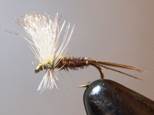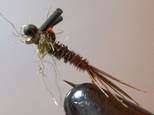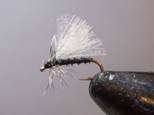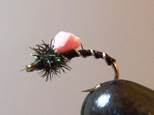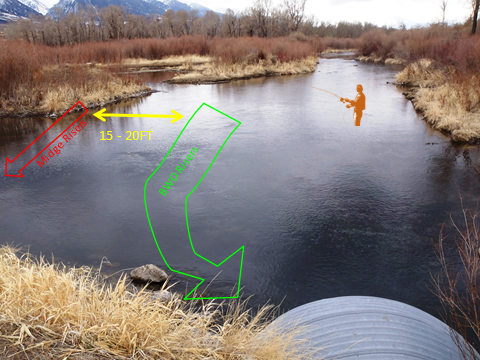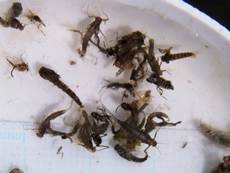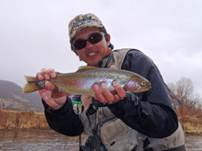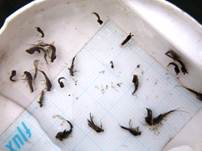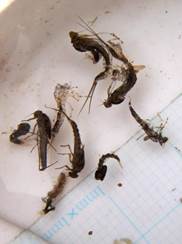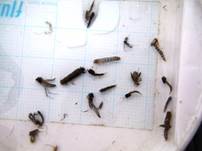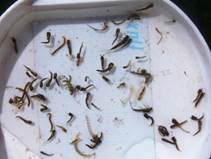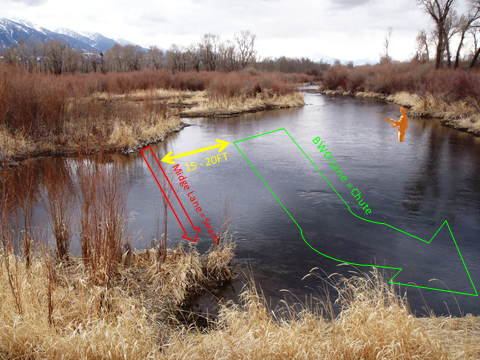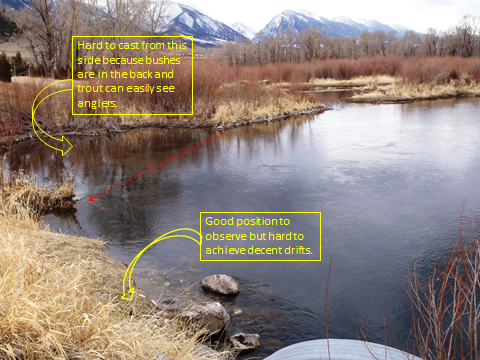15 FEET AWAY
PROLOGUE: I'm in the middle of enjoying spring weather and great fishing at DePuy Spring Creek (www.depuyspringcreek.com) in Paradise Valley, MT. I may be supposed to update my blog or tie more flies in my house but I asked the editor to let me write about a very interesting situation I'm experiencing at the creek. It's amusing: what really makes a spring creek technical and challenging. At a certain spot of the creek, insect hatches and trout behavior are offering me a very enjoyable yet very challenging situation.
HATCH: Midges hatch all through the year at the creek. Spring Blue Winged Olive (hereafter BWO) can be observed from February. However, this doesn't mean trout would rise at them accordingly; for trout to rise the weather and intensity of hatches have to be decent, otherwise the trout would simply keep feeding on underwater sources. Finally in March, winter is coming to an end in Paradise Valley. Air temperatures will rise. Although a spring-fed creek will never be frozen during winter months, surely it can be colder. So in March, the creek water temperature also will rise. First more midges start to hatch. BWO nymphs become very active from February to early March (BWO nymph patterns are very effective during this period). Then from middle of the month, more BWO are present in the air. With all these conditions set, trout finally start to rise. On most of days, midge hatches start from 12:30 to 1:00 pm and may last till 4:00 pm or even later. Then BWO hatches follow from 2:00 pm. BWO hatches are really weather dependent. On very sunny days, there may be total of only a few in the air and on the water. Normally they can last till 3:00 to 3:30 pm. Then on cloudy or rainy days, even snowy days and they can last till 4 pm. Most importantly for both hatches, if southwest winds are blowing at 40 MPH or harder, all insects will be blown away to Canada and waves make trout shy to rise.
PLACE: I fish and observe all along three miles of the creek. I've been looking for good spots to fish for hatches with rising trout and one certain spot has been meeting my expectation. During the first couple days of fishing there, I noticed trout were locking in and feeding at one main current in the middle. I positioned myself at A or B originally and successfully took trout. As days passed by, I started to see another feeding lane by the edge of the spot. It could be observed from Positions A and B but hard (almost impossible) to have decent drifts from there. Eventually I found Position C would be suitable to fish both lanes.
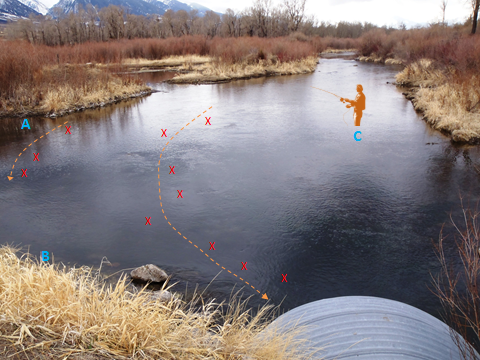 |
RIGGING: I use my own design, Pheasant Tail Mayfly Cripple – BWO, as a pilot fly (of course it's a super effective dry-fly itself!!). Under that, I trail either Winged Victory Nymph – BWO, Goose Biot Midge, or Foam Wing Emerger Type 1. Although there are more effective patterns and combinations, I omit them for this writing. I'm experiencing sunny days and the creek level is the lowest of the year, so I use 5X and 6X for the top fly and trailer flies, respectively.
|
|
|
|
Pheasant Tail Mayfly Cripple – Yamamoto's |
Winged Victory Nymph-BWO – Yamamoto's |
Goose Biot Midge |
Foam Wing Emerger Type 1 – Yamamoto's |
WHAT'S TAKEN: As both hatches became strong, I simply assumed BWO would be main dish for trout. From Position C, I took many trout in the middle feeding lane with the ultimate combination of Pheasant Tail Mayfly Cripple and Winged Victory Nymph. I would cast further from Position C to the other lane at the edge. But my BWO combo wouldn't work there. So I tied on midge patterns and BINGO, I hooked those quiet risers. I didn't pay much attention at first. I just thought it would be just "preference" rather than "selectivity". However, the more I fished two feeding lanes and collected stomach samples from almost all trout I had caught, the more I realized the distinction did exist between two lanes (or two groups of trout underneath). It's ONLY 15 FEET AWAY at the same spot!!
|
STOMACH CONTENTS: I wish I could show you all of my stomach sample pictures from each feeding lane. I have caught many more trout from each lane and recorded stomach samples. Samples from one lane had the same tendency, which was different from the other. Let's start with a general trout which was smaller and a bit easier to be caught, i.e., rose on dry-flies with decent drift (at either lane).
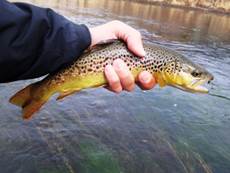 |
|
Just a regular trout. |
Mix of everything: BWO duns and nymphs & Midge adults and pupae. |
Here's the set of pictures with a very selective trout. It was at the very end of the middle feeding lane (by the culvert). Its rise form was "dorsal-tail", slicing ascending nymphs just below the surface. Winged Victory Nymph was taken without any doubt. Stomach content supported my observation: mostly BWO (duns and nymphs) in this feeding lane yet ascending nymphs were dominant (selectively taken). I caught more trout with this method in this feeding lane and all stomach samples showed the same tendency.
|
|
|
Very nice rainbow!! |
Notice: more BWO than midges. |
Furthermore, more ascending nymphs than duns. |
Here's the set of pictures from quiet risers at the edge lane. Only 15 feet away and while both hatches were going on = same time of the day, trout in this feeding lane were exclusively feeding on midges (mostly pupae)!! As you can see, there were almost all NO BWO in their stomachs (pupae dominant)!! I also caught more trout from this feeding lane and conducted stomach pumps. All samples had similar contents.
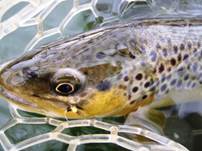 |
|
|
One of sippers can be large like this! |
His content: midge dominant. |
Content of the other trout in the same feeding lane = midge dominant too. |
ANALYSIS – BWO LANE: Picture from another angle for this spot gives us some visual aspects. This is apparently a main current. It's the "chute" among weed-beds. See bare bottom, which gets larger toward the end. That's where flow is strong = BWO duns are on top and nymphs are in the column. Also that's where trout hide and feed. Of course midges are present in this lane too and trout will feed on them before BWO start to hatch. But once BWO appear constantly, trout in this lane focus on bigger meals.
|
ANALYSIS – MIDGE LANE: As I wrote above, I first didn't pay much attention and that was why I was fishing from Positions A and B, sacrificing this lane. But the more I visited, the more I saw trout rising in this lane. That was why I figured out Position C, crossing to the other side way above risers in both lanes, so I was able to cast toward both lanes. Picture from another angle shows some character of this lane. It's the "seam" between currents and a tiny slough at the edge of the creek. This little slough is almost all like a tiny still water spot with a muddy bottom. That's why midges are present and hatching in abundance. Hence, although BWO are hatching in a reasonable intensity, some trout would choose to stay away from a heavy main current and sip on midges in a calm spot. I observed trout were literally settling just under the "seam" of slough and currents. When they spotted threats (such as myself), they quickly merged into currents. They really were sippers. They didn't really swim around. They moved only to feed on ascending pupae right in front of them (and adults on surface occasionally).
|
EPILOGUE: I have just ruminated my mantras again and again: "learning and observation will never" and "spring creek is the classroom of fly-fishing" (by Tom Travis). There are many publications that emphasize how technical spring creek fishing is and how selective trout in spring creeks can be. But no other writing can put significant meaning of "technical" and "selective" than this real experience of mine. Also there are many books and articles that explain micro-habitat of various insects in big rivers, such as Yellowstone and Madison Rivers, because those are miles long and yards wide. But the micro-habitats I'm working on are ONLY 15 to 20 feet away in a creek where I fish several days a week!! Besides observing insects and trout behaviors, whole experience stimulates me to develop more new patterns. Right after I submit this writing to the editor, I will be at the creek and observe what's going on this afternoon. I keep you updated if I observe something new and if my new patterns are accepted. See you at the creek!

